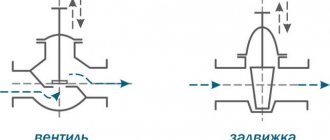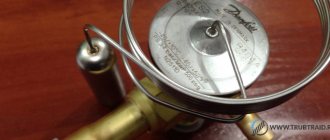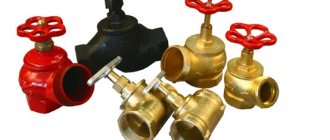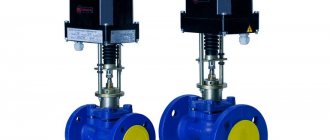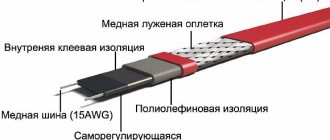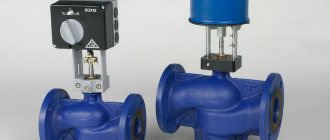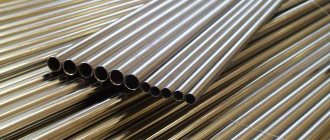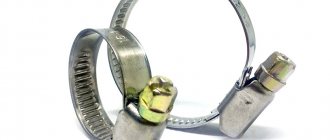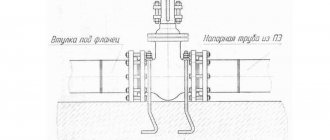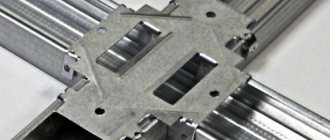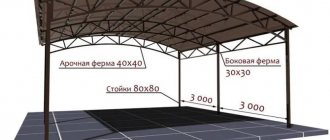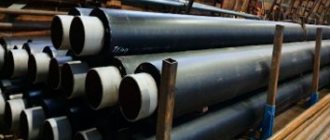To change the flow rate of the transported media until it stops completely, shut-off and control valves are used. The water tap valve has the following properties:
- simplicity of design and operation;
- application at large pressure drops;
- small size and weight;
- Possibility of installation on any section of the pipeline;
- The short shutter stroke ensures convenient maintenance.
Classification of locking devices
First of all, all taps are divided into 3 groups:
- shut-off valves, which can be set to the “Open” and “Closed” positions;
- regulating, allowing you to change the force of the flow;
- combined, combining both functions.
According to their internal structure, valves can be:
- ball (with a round locking element equipped with a through hole);
- disk (overlap is carried out by lowering a cone in the form of a plug).
According to the type of control, the shut-off valve can be actuated:
- mechanically (flywheel), i.e. manually;
- using electric drives, including from a remote control.
Installation
To install the valve, you do not need to have any specific skills. It is enough to follow the step-by-step instructions without breaking the sequence. Installation steps:
- Before installing the valve, clear space in the place where the mechanism will be installed.
- Turn off the water so that it does not interfere with work. Drain the excess liquid through the drainage system from the system. There must be separate taps for this.
- The solid pipe is cut using a cutter to fit the locking element.
- Threads are cut at the ends of the pipes using special dies. Use a wire brush to remove shavings.
- The thread is covered with a sealing thread to create a more reliable connection. Some plumbers use sealant.
- The valve is installed between the pipes and screwed onto the thread. Clamped with a wrench.
Next, the valve that held the flow of liquid opens. It is necessary to check the reliability of the connection at different pressure levels. This is how you can replace an old valve at home
It is important to ensure that the locking element is screwed onto the thread. Distortions that could destroy the integrity of the system should not be allowed
If the valve has a flange, additional pipe preparation is required. To do this, they are cut, and metal plates with holes for fasteners are welded at the ends. Next, a valve is installed between the pipes. A rubber gasket is secured between the flanges using waterproof glue. The structure is secured with bolts and nuts. Additionally, you can weld the flanges using a welding machine. The seam must be cleaned with a grinding machine and coated with an anti-corrosion compound.
Shut-off valves are necessary elements of any system working with gases and liquids. With their help, the power of liquid or gas supply changes and the flow is completely blocked. Installation can be carried out by anyone, knowing the step-by-step instructions.
Device and principle of operation
The design of the tap valve, as well as the principle of its operation, depend on the type.
Design and principle of operation of a ball valve
How does a ball valve work? The main elements of the device are:
- valve body (1). The body can be made of materials such as brass, bronze, stainless or structural steel, silumin. The body can be solid, that is, made by welding, or collapsible. The collapsible body has some advantage - if necessary, the valve can be repaired. If a ball valve with a solid body is installed, then if there are any malfunctions, the device must be replaced;
Basic elements of a ball valve
- locking element – ball (2). In most cases, the ball is made of brass, as this material is considered stronger and more durable. The ball has a passage hole for liquid (gas);
- O-rings (3) are installed between the locking element and the body to ensure the tightness of the device. Gaskets can be made of Teflon, fluoroplastic or rubber. Teflon seals are considered the most durable; they are practically unaffected by temperature and chemical environments;
- The valve can be connected to the pipeline using nuts (couplings), flanges or welding (4).
In domestic pipelines, a coupling connection is most often used, and in industrial pipelines, a flange connection is used. Welded valves are currently used extremely rarely, as they require special equipment and certain skills during installation.
Valve with flange connection
- The shut-off ball is driven by a rod (5), which is connected to the control handle (6). Sealing elements are also installed between the rod and the handle;
- the handle is attached to the body using a nut (7).
The operating principle of a ball type valve is as follows. When you turn the handle attached to the body, the locking element of the device - the ball - rotates. If the passage hole of the ball is turned in the direction of the flow of the passing substance, the valve will be open. If the passage hole is turned perpendicular to the flow, the valve will be in the closed position.
Operating principle of a ball valve
The design of a ball valve, as well as points that you need to pay attention to when purchasing a product, are discussed in detail in the video. https://www.youtube.com/embed/mMhsfT41gU8
Design and principle of operation of a valve valve
Now let's figure out how a valve equipped with a valve works. The device consists of the following elements:
- The valve body (2), made of various materials, is equipped with a cover (3). For tightness, a gasket (12) is installed between the body and the cover. As a rule, the gasket is made of durable rubber, but can also be made of other materials;
Main operating elements of a valve with a valve shut-off element
- the body is equipped with a seat (1) for the valve (6), which is the locking mechanism of the device. To completely shut off the flow and seal, the seat is supplemented with a sealing gasket (16);
- there is also a seal (15) on the bottom of the valve;
- The bushing (7) and spindle (11) are attached to the shut-off valve using a nut (14);
- there is a thread (4) on the spindle body, which serves to control the locking cone;
- the spindle is combined with a flywheel (8), which drives the valve. The flywheel is secured to the device body using a nut (13);
- For a hermetically sealed connection between the flywheel and the valve body, an oil seal (10) is installed, secured with a separate nut (5), supplemented with an o-ring (9).
The design of the valve also determines the principle of its operation. When the flywheel rotates in translational movements up or down, the spindle moves, which lowers or raises the valve.
Operating principle of a valve
The valve can be straight-through (in the figures above) or angular. It is recommended to install an angle valve on a pipeline bend. The design and principle of operation of an angle valve are practically no different from a straight-through device. The main difference is the shape of the body and the placement of the saddle.
Valve type angle valve device
Ball valves and valve valves have different designs and differ in operating principles. However, both types of products can be installed on household pipelines for various purposes.
Which one is better to choose?
Choosing a mixer is not easy. After all, you want it to be compact, reliable, firmly “sit” in the workplace, match the style of the room and not break down for a long time.
- For the kitchen, it is advisable to choose a valve made of brass, bronze, copper with a chrome or gold coating, on which grease does not linger and dirt is easily washed off. Such faucets are durable and expensive, they are not susceptible to oxidation and rust. The faucet should also have a swivel spout with a gander height convenient for washing dishes. The price of a quality product starts from 5 thousand rubles.
- For the bathroom - the faucet body and spout should be made of brass, preferably having a replaceable cartridge. This can be a ball mixer equipped with a single lever handle or a two-valve tap. Many people prefer a ceramic water tap, i.e. with ceramic cartridge. The sealing element in it is a ceramic ring. Such products withstand the effects of hot water better, adjust more smoothly than taps with a rubber seal, last a long time, and require less repair and maintenance. Of course, with such characteristics, a ceramic faucet also has a considerable price - from 4.0 to 35.0 thousand rubles (depending on the manufacturer).
- For other situations. In utility rooms and garages, an inexpensive single-valve tap will suffice. The price of such products varies from 1.5 to 3.5 thousand rubles.
Types by connection principle
The ball valve differs in the material used in its manufacture, and also in the principle of connection to the pipe.
Coupled
A ball joint water tap is a design with threads at the ends. This type is used for industry and housing and communal services. Diameter range 8 – 100. The body is made of bronze, steel and stainless steel.
The advantages of this type of product include low weight, length, and low cost. The disadvantages include the difficulty of repair and maintenance.
Carving is divided into several types:
- VN-VN - internal thread on both ends of the product;
- NAR-NAR – external thread on both sides;
- Fitting - inside thread with fitting;
- VN-NAR - one thread is inside, and the other is outside;
- With the American one there is a thread inside on one side, and a union nut on the other.
Flanged
This type connects with a return flange. Diameter range from 15 to 800. The body is made of cast iron, steel and stainless steel.
Among the advantages of this type are:
- Ease of installation and maintenance;
- Can be used for any pressure indicator.
Disadvantages of this connection:
- Large weight and size;
- The bolt tie becomes loose, which means that over time this will lead to a decrease in tightness.
Welding
The ends are made specifically for welding. They produce products in sizes 10 – 800. The material is made of steel and stainless steel.
Advantages of the welding product:
- Absolute tightness;
- Weight and length are less than flanged ones.
Disadvantages of this type:
- There is no possibility of service;
- Difficult to install;
- Difficult to replace.
Mounting methods
Water valves can be connected to the process in different ways: fixed using special elements or mounted by welding.
Flange connection
This type of connection uses a special metal flange with a rubber gasket.
Loose flanges are placed on the end of the pipe and the valve nozzle, a gasket is installed between them, then the entire assembly is bolted together.
Coupling fittings
The connecting pipe has an internal thread with a fine pitch, and the outside is shaped like a hexagon for ease of use with a wrench. The coupling is screwed onto the thread and sealed with flax strands or FUM tape.
Tsapkova
This method of fastening is characterized by the presence of an external thread at the end of the connecting pipe and a collar at the end of the pipeline.
The valve branch pipe is pressed against the pipe with its end and secured in this position using a union nut. The tightness of the connection is ensured by a metal gasket and special lubricants.
Choke
The fitting is a short piece of pipe (bushing) with internal threads at both ends. With this type of connection, the connecting ends of the fittings are screwed onto the pipe and secured with a union nut.
Welding
This is a one-piece type of connection, the tightness of which is ensured by welding.
Device classification
According to the method of shutting off the flow of the working medium, there are four types of valves.
Screw. The movable valve is secured to the stem with a threaded connection. It presses against the seat located in the valve body. Tightness is ensured by the stuffing box, which is a sealing washer. This valve has the following specific disadvantages:
- capable of passing liquid in only one direction;
- Wear of paronite or rubber gaskets requires their periodic replacement. And scale or sand that gets under the valve can cause their partial or complete destruction.
Gate. In design, they are more reminiscent of a gate valve than a valve: a conical valve is lowered between two mirrors using a threaded rod. Instead of an oil seal, durable polymer or rubber seals are often used.
Ball valve is the most modern design of such devices
Ball. A ball made of stainless steel or brass with a through hole rotates in the valve body when the handle is turned. It is fixed with a pair of fluoroplastic or Teflon ring seats. The rod is sealed by a gasket made of the same material.
Cork. The flow in them is blocked by a conical plug with a through hole. Typical problems are:
- periodic packing of the oil seal is required;
- Turning the plug in a large valve requires considerable effort.
Controls and technical characteristics
Manual control has now been replaced by modern methods of controlling control valves, based on the use of various types of drives and combinations of sensors that detect the slightest changes in the state of the pipeline contents.
According to the purpose and conditions of use, the following types of control are used:
- hydraulic;
- electrical;
- electromagnetic.
- pneumatic.
Like other types of valves, the main technical parameters of the control valve are:
- capacity in Kv;
- diameter DN;
- nominal pressure rating;
- working temperature.
The specified characteristics can be found in the technical documentation supplied by the manufacturers to the product.
Construction of a simple water tap
The design of the crane may vary depending on the design features of a particular model, but the principle of their operation, as well as the composition of the main functional elements, remains unchanged.
The crane consists of the following elements:
- mounting screw;
- valve handles;
- stuffing box;
- tap covers;
- stuffing box;
- spindle;
- nuts on the valve body;
- gaskets;
- faucet spout;
- valve seats.
The valve (handle-handwheel) of the faucet is connected to a vertical spindle. The lower part of the spindle, 20 mm long, can move inside the nut. The outer part of the nut is screwed into the valve body. At the end of the spindle there is a spool, which consists of a disk with a gasket.
The gasket is secured using a nut or button. When you turn the faucet handle, the spindle is screwed in, thereby shutting off the faucet: the gasket comes into close contact with the metal protrusion - the faucet seat, and creates a barrier to the flow of water.
To eliminate the possibility of water penetrating up the spindle when the tap is opened, an oil seal bushing is provided, which is located in the upper part of the spindle. Water insulation is created using gland packing, a waterproof material that tightly seals water.
What is the difference between a valve and a faucet?
The difference is not in the type of valves, as many people, even plumbers, are accustomed to thinking. Taps and valves are different, although they are often called by the same name. This difference lies in the design of the housing. If the valve is intended to be installed at the junction of two pipes in order to, if necessary, shut off the liquid supply, then the tap is located at the end of the pipeline. A tap is a kind of limit switch that serves to supply water when the need arises.
Now you need to find out what is the difference between a valve and a gate valve. Many people believe that there is no difference between a valve and a valve, however, this is not true. What a valve is and why it is needed is already known. Now let's analyze the valve to find out its main differences from the valve.
The valve performs similar tasks as the devices discussed in the material. However, the valve is not able to regulate the flow rate, so it only closes and opens the flow. The valve cannot regulate the liquid pressure due to its design features. The damper in such a device moves only up and down. The difference between a gate valve and a valve can be seen clearly in the photo below.
Installing a valve on plastic pipes
In most cases, plastic valves are installed on plastic pipes. To install the device you will need:
- scissors for cutting pipes;
- device for welding plastic pipes;
- valve.
Plastic pipe welding machine
The process of installing a valve on a plastic pipe is as follows:
- cutting out the section of pipe required for installation of the device;
- alignment of pipe ends;
- heating the prepared areas on the welding machine;
- pipe connection.
To obtain a reliable connection, it is recommended to keep the parts until they cool completely.
Scheme for installing fittings on plastic pipes
Having certain skills and knowing the simplest instructions, you can install the valve on various types of pipes yourself. If a person doubts his abilities, then he can call a professional master to carry out the work.
Materials and components
The materials used for the manufacture of shut-off valves and components must comply with the general technical specifications in accordance with the standards of the Central Design Bureau of Valve Engineering (TsKBA) “Pipeline Valves. General technical conditions”, put into effect in January 2006, as well as current national standards and industry specifications. The main criterion in choosing a material for the body of any fitting is its strength. The housing is the basis for installing all other parts into it. It is like a foundation in construction - a supporting structure for the whole building.
The bodies of most pipeline shut-off devices are made of cast iron or steel. Sometimes other metal materials are used for this: bronze, copper, aluminum and brass taps and valves for household appliances are commercially available. Fittings made of non-ferrous metals and their alloys have a good feature - they are not subject to corrosion and have a good appearance.
The most economical material for fittings is plastic, which under its general name combines products made from PVC (polyvinyl chloride), polypropylene, polyethylene and other artificial alloys of plastic material. But such fittings cannot withstand high pressure and temperatures, as they are not durable. But for pipes of small diameter and low pressures, this is a completely suitable alternative to metal products. In addition to being cheap, plastic pipelines and fittings are valuable for their resistance to corrosion - the main scourge of similar steel devices.
For casting valve bodies, malleable, gray or high-strength cast iron is used, depending on the area and conditions of use of a particular product. Due to their fragility, fittings with a cast iron body are not used at high pressures in pipelines, as well as where water hammer and sudden temperature changes may occur. In such situations, the cast iron body may simply burst.
Steel cases are made from various grades of steel: alloy, heat-resistant and carbon. For the manufacture of valve bodies installed on pipelines with aggressive substances or having a particularly clean working environment, stainless steel with high corrosion resistance is used. Housings made of heat-resistant steel are used for valves operating at elevated operating temperatures. The use of a particular material, as well as the design and type of flange, are determined by a number of factors, the main of which are the following:
- nominal diameter of pipelines;
- working environment pressure;
- flow direction;
- temperature conditions.
The sealing materials are:
- metal products in the form of rings that have corrosion resistance, anti-friction properties, and are well processed (steel, brass, bronze, monel);
- deposition of various hard alloys: stellite (cobalt alloy), sormite (iron-based alloys);
- non-metallic products (rubber and rubber-metal rings, polymer seals);
- sealing packings made of material of plant origin (cotton and flax fiber), talc, fiberglass;
- fluoroplastic and graphite for stuffing box seals in aggressive and high-temperature working environments;
- sheet rubber, paranit and fluoroplastic for gaskets.
Cast iron and steel fittings equipped with flanges have undeniable advantages in terms of tightness, maintainability and strength of the pipeline network compared to flangeless ones. But the mass and dimensions of such reinforcement sometimes reach large values (in tons and several meters, respectively). To this we also need to add control devices (hand wheel, electric drive or pneumatic drive, mounted on the valve). Flanges lead to increased metal consumption and labor intensity in their manufacture.
Repair of a water tap due to valve malfunctions
During prolonged use of a water tap, the walls of the tap socket may become chipped. If most of the circumference is damaged, the valve cannot be repaired, since in such a seat the gasket is not centered, fidgeting in the seat, as a result of which it begins.
In such cases, the valve is purchased in a store or turned on a lathe from brass. When recessing the valve yourself, it is necessary to provide for the presence of a so-called undercut - the diameter of the base of the socket should be 1-1.5 mm greater than the diameter of the edge of the socket, which allows the gasket to be securely held without using a screw.
You can also change the valve by removing it from an old faucet head, which may be in stock from a previous repair.
When unscrewing the head, the valve may remain in the valve seat. To remove it, use a wire hook or tweezers.
To avoid the valve falling out of the spindle, it is necessary to wind the shank with linen winding and insert it into the spindle with force. Linen threads will wear out over time and come out with water.
Scope of application of shut-off valves
Shut-off valves are intended:
- for pipelines supplying gas or water to residential, domestic and industrial premises and discharging sewage. This is the widest scope of application of locking devices;
- for pipelines carrying aggressive substances. Devices for the chemical and oil and gas industries will demand higher tightness and corrosion resistance;
- household water supply, heating and sewerage networks. The fittings installed on private networks are small in size and easy to manage.
Only fittings that are intended specifically for this type can be installed on the pipeline.
Options for wiring diagrams of a two-pipe system
Upper wiring
A system with overhead wiring is suitable when implementing natural circulation (without the use of pumps) (gravity heating system). It has lower hydrodynamic resistance. In this case, the upper supply main pipe is partially cooled. Due to this, additional coolant circulation pressure is generated.
Bottom wiring
In a system with bottom wiring, both the supply and discharge pipes are located nearby.
There are such modifications of the lower wiring:
- “star” (radial) - from the collector to the radiator there is its own supply and its own return pipe;
- “loop” - collectors bypass all radiators in series
The principle of difference between one-pipe and two-pipe wiring
So, is the heating system one-pipe or two-pipe? In each case, it is necessary to have preliminary calculations and a design (see Leningradka single-pipe heating system), on the basis of which both heating devices and the main pipes themselves will be selected (see reinforced polypropylene pipes for heating). The final decision is yours.
Types of locking elements
Today there are 2 main types of water taps and valves:
- ball;
- valve
Simplicity of design and ease of use have made this fittings in demand among consumers. It has an acceptable service life and is widely used as a shut-off valve not only in water supply systems, but also in gas networks.
The design of this device does not allow it to be used to regulate fluid flow. The main disadvantage of the ball valve is considered to be complete non-repairability.
Due to their design features, valve fittings have a short service life, since sealing elements made of leather or rubber quickly fail. However, it is possible to replace them, which extends the operating time without compromising performance.
Depending on the method of fastening the valves, the corresponding fasteners are used. In domestic systems, a coupling connection (American) or squeegees are most often used, and in industry, on high-pressure pipelines that do not allow leakage of working media, the fittings are installed by welding.
Types of locking mechanism
According to the type of constipation, all water valves and taps are divided into several types:
- Valve;
- Ball;
- Cork.
Below we will take a closer look at the features of all types of these devices.
Valve valve device
Valve
Valve taps are the usual locking mechanisms. The principle of their operation is based on blocking the passage with an elastic gasket mounted on the rod. The position of the rod is adjusted by a handwheel using a worm mechanism.
Thus, when the handle is rotated, the rod rises, resulting in the passage for water opening.
Among the advantages of this mechanism are:
- Ability to withstand high pressure;
- Ability to control flow;
- Ease of Management;
- Possibility of repair.
Along with the advantages, these products also have some disadvantages:
The gasket quickly fails because it comes into contact not only with water, but also with a metal surface. True, you can replace it yourself. As a rule, the device comes with an assembly drawing of the water valve, which shows how to disassemble the mechanism and replace damaged parts.
Removing the axle box gasket
- To completely open or block the passage, you need to make several turns of the flywheel yourself, which is not very convenient.
- The mechanism is less durable than other types of fittings.
For these reasons, recently such taps are installed quite rarely, only in cases where it is necessary to regulate the flow.
In the photo - a ball valve with a diameter of ¾
Ball
Ball water valves have recently become the most common. They received this name as a result of the fact that the locking mechanism is made in the form of a ball with a through hole. To block the flow, the ball is rotated with its hole perpendicular to the pipeline.
The plumbing ball valve has a number of advantages, such as:
- Durability due to the simplicity of the mechanism;
- Tightness when the passage is closed;
- To open the passage, you only need to turn the handle 90 degrees;
- Affordable price;
- Possibility of use in conjunction with servos and other devices that allow you to control the mechanism remotely or install it in automatic flow shut-off systems. (See also the article How to choose a mixer: features.)
Ball mechanism diagram
As for the shortcomings, there are few of them:
- The operating instructions for the device imply its use only to completely block or open a passage, i.e. it cannot be used to regulate flow. Otherwise, the mechanism will quickly depressurize.
- If the mechanism fails, it cannot be repaired.
Most often, this type of fittings is used in plumbing systems.
Plug tap
Cork
The design of a plug-type water valve resembles a valve valve, the only thing is that the flow is shut off using a conical plug, which is attached to the stem. When the rod is lowered, the plug enters the hole and tightly blocks the passage.
It should be noted that in recent years such fittings have been used extremely rarely in water supply systems, since more durable ball valves are installed instead.
Plastic ball valve 1 2 inches
How to install it yourself?
Proper installation of a water valve is important for its safe operation and longer service life. In principle, the installation itself proceeds according to the following scheme:
- The water supply system is shut off.
- Open all the taps to allow any remaining water to drain from the pipes.
- Dismantle the worn device. The choice of dismantling method depends on the type of connection of the old product:
- pin-type - use a wrench to loosen the union nut;
- coupling - by dismantling the coupling;
- flanged - loosen the bolts used to secure the mounting flanges;
- welded - a section of pipe is cut out using a welding machine.
- Clean the pipe at the installation site from residual sealant and rust;
- Install a new valve, sealing the threaded part of the fum connection with Tangit Unilok tape or thread. For a flanged valve, no sealing material is required. Unlike fittings with a collapsible type of connection, installation of a welded device will require a special apparatus for soldering pipes.
However, there are a number of nuances that should be taken into account when working:
- choosing a convenient place to install the product so that there is no interference with the movement of the lever or handle;
- The thread may need to be lengthened. If the valve is being replaced, then after dismantling the old device, you need to clean the threads of the pipe from any remaining sealing material and try to screw a new product onto it. Quite often, during operation, corrosion destroys the metal on two or three turns of the threaded part, so it is necessary to cut off the missing turns;
- The product must be installed taking into account the direction of flow of the working medium indicated on the body of this type of shut-off valve.
Features of the design of mixers with a thermostat
Modern technologies make using the mixer simpler and more convenient. Devices equipped with a thermostat are gradually gaining popularity. What distinguishes them from a conventional faucet is the presence of a thermocouple that controls the flow of hot and cold water to bring the flow to a predetermined temperature. A handle is mounted outside, with which the temperature indicators are set. Another lever regulates the water pressure coming from the spout.
Water faucets with a temperature sensor are very convenient to use. Using the valve, only the pressure of the water flow is regulated, and the temperature value can be set in advance
Read more about this type of faucets in the article: Faucet with a thermostat: design and principle of operation + example of self-installation.
ball or valve Find out what the essence of the choice is.
The choice of shut-off valves for residential use cannot be underestimated. It is hardly worth saying that not only the absence of problems, but also the comfort of operation fully depends on the reliability of the selected cranes. Below you will find basic recommendations for choosing faucets for your apartment/cottage.
Cranes in Stream Market today are presented in a wide range. The point is that you can easily purchase shut-off valves from the world's leading manufacturers of plumbing equipment. By understanding the basic selection criteria, you will protect yourself from problems with water supply and heating.
Benefits of using ball valves
Indeed, almost all specialists working in the field of organizing water supply networks or heating speak about the need to use ball valves.
This part of the water supply network has the following advantages:
However, the positive aspects mostly concern European manufacturers of shut-off valves. Note that maximum attention should be paid to the choice of the alloy from which the ball valves are made.
In addition, choosing combo solutions is not recommended. An example is the widespread Italian product, where a ball valve is connected by a permanent connection to a coarse filter.
Thus, if the shut-off valve itself fails, you immediately lose filtration in the system.
Why are they trying to avoid using valves?
The design of plumbing valves is imperfect. To open it completely you have to perform a large number of turns of the handle. While for a similar action, a ball valve requires only one movement of the hand.
The valve may get stuck. It will be almost impossible to unscrew it by hand. However, when force is applied to the valve handle using an extended lever, the threads are “licked off” and the shut-off valve can no longer be used for its intended purpose.
We have to carry out work to replace it.
The video will tell you which type of taps is best for heating radiators:
Based on materials: https://stream-market.com.ua/krany_sharovye_zapornaya_armatura
Tweet
Shower faucets
The device is made as a single-lever ball valve or in the form of two valve valves. The kit includes a replacement shower head with attached flexible hose and bathtub spout. The mixer is hidden, with only the water temperature control valves exposed.
The classic option is a two-valve accessory with manual temperature control. Cold and hot water are mixed in a special chamber and then flowed into the shower hose or spout. The main elements of the device are two crane axle boxes with replaceable gaskets.
A single-lever device with convenient water adjustment is becoming popular. The main element of the mixer is a replaceable cartridge. If it fails, it can be easily removed and replaced with a new one.
With a built-in thermostat, adjustments are simplified. It is pre-set, which guarantees water output at the desired temperature. For this purpose, the housing contains a thermostatic element that distributes the flow. The only drawback of such models is the high price.
Removing blockages and painting
Often, a water valve needs painting, which is a great time to check and clean it. It is necessary to completely remove the old paint, inspect the surface of the mechanism, and prime the metal with drying oil.
We must not forget that complete removal of the valve will inevitably entail shutting off the water intake on the riser, so if it is possible to make repairs without turning it off, this should not be neglected.
It is often necessary to remove blockages that are preventing water from flowing with sufficient pressure. Serious blockages require complete removal of the valve, but small ones can be removed very simply, even without the use of special tools.
This can be done like this: you need to turn on all the taps in the house, including the tap on the cistern. Then open and close the water valve a couple of times. The pressure will rise significantly, and a small blockage will simply be washed away by the pressure of water on its own.
The gasket itself is very similar to the material for the tap, but it is stronger and denser, because it is under high loads.
We recommend installing fiber, paronite or heat-resistant rubber under the gasket, because elevated temperatures (for a pipeline with hot water) significantly deteriorate the properties of the rubber gasket.
Replacement may be necessary for both the stem and the spindle, also remember to lubricate the handle to turn off the water pressure, make sure that the valve fasteners are tight.
How to choose a needle valve
When choosing a valve, it is important to consider the following criteria:
- characteristics of the pumped substance: viscosity, chemical activity, density;
- work pressure in communications;
- type of connection to pipes;
- environmental conditions: temperature, humidity level, presence of mechanical influences.
Recommendations for choosing the material from which needle taps are made:
- in areas of communications with low pressure and low technical requirements, cast iron products are suitable;
- if it is necessary to ensure high corrosion resistance, bronze fittings are suitable;
- in heating systems, it is advantageous to install taps made of heat-resistant CrMo steel, which can withstand water hammer, mechanical stress, and temperature changes;
- Shut-off valves made of carbon or stainless steel are used on highways.
Recommendations:
- for high-pressure systems, carbon steel structures are suitable;
- when operating in unheated rooms or at high humidity, it is better to choose housings made of stainless steel, nickel-plated steel, bronze;
- you should purchase products from well-known manufacturers so that all declared characteristics correspond to real ones;
- it is necessary to take into account the quality of assembly, the absence of stem play, external damage, and dimensional discrepancies with standards.
The housing material must correspond to the characteristics of the transported medium. This is due to its chemical activity, oxidizing properties, and physical parameters.
Installation of shut-off valves in the system
In a heated towel rail system, a shut-off fitting closes the radiator and at the same time the flow of warm air. The valve position is adjusted using a control handwheel or a small switch knob (in modern products).
When installing a valve, the material from which it is made and the design type (ball, valve) are taken into account. Installation can be threaded or flanged. The first type is performed when small diameter pipes need to be connected to the system - up to 6 cm, the second - for large-sized pipes (up to 160 cm).
To install a “Grohe” or “Hansgrohe” thermostatic locking mechanism on a heated towel rail, you must:
- Screw the valve into the coupling
- On the other side, attach a pipe to the coupling. This is achieved by screwing the threaded pipe fitting into the fitting seat.
- Seal the joints of individual elements with fluoroplastic film. If a brass corner valve is installed, the joints can be soldered by welding.
